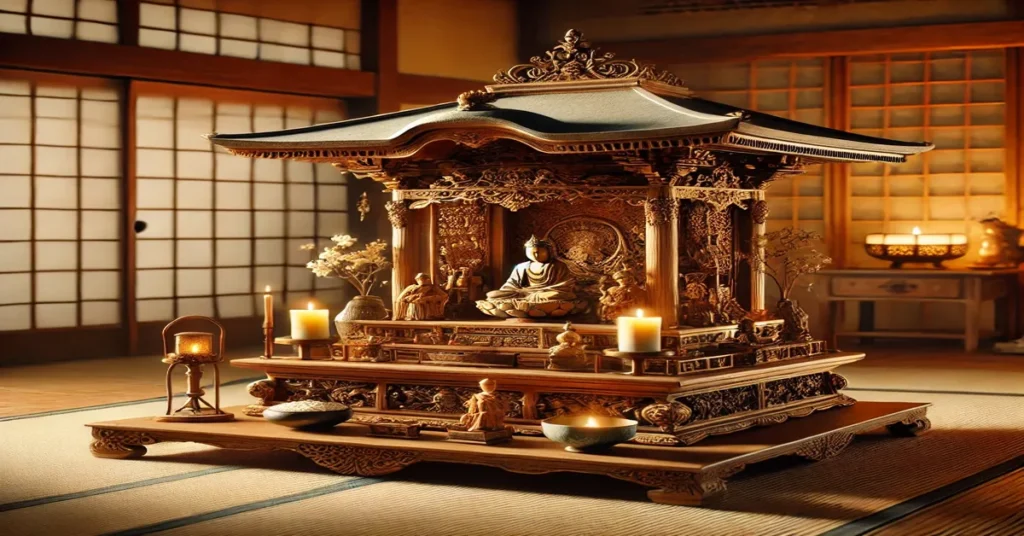Japanese antique home shrine, also known as butsudan (仏壇) and kamidana (神棚), are integral parts of traditional Japanese homes and embody the deep-rooted spiritual and cultural practices of the Japanese people. These shrines hold a special place in Japanese households, serving as a point of connection to ancestors, deities, and spirits. Today, antique Japanese home shrines are treasured not only for their religious significance but also as beautiful works of art, cherished by collectors and appreciated by enthusiasts worldwide.
In this article, we will explore the history, types, and cultural significance of Japanese home shrines, with a focus on antique versions. We will also examine how these shrines are used, maintained, and appreciated as artifacts of Japanese cultural heritage.
The History of Japanese Home Shrines
The tradition of having a home shrine dates back to the Heian period (794–1185 AD), though it became widely popular and standardized during the Edo period (1603–1868). Over the centuries, Japanese shrines evolved in style, form, and purpose, with variations influenced by Shinto, Buddhist, and regional beliefs.
- Shinto Influence: Shinto, Japan’s indigenous religion, emphasizes the veneration of kami (spirits or deities) associated with natural elements, ancestors, and various aspects of life. Shinto shrines, known as kamidana, are dedicated to these kami and are typically small wooden structures adorned with Shinto symbols, including ofuda (paper talismans) and gohei (paper streamers). These shrines are often placed in a high, respectful place within the home.
- Buddhist Influence: With the introduction of Buddhism to Japan in the 6th century, Buddhist shrines, known as butsudan, became common in Japanese households. A butsudan typically contains images or statues of the Buddha or other deities and is used to honor ancestors. This tradition reflects the syncretism of Buddhism and ancestor worship in Japan.
During the Edo period, the practice of maintaining a butsudan or kamidana in the home was formalized, and specific rituals associated with these shrines became widespread. This practice grew even more popular in the Meiji period (1868–1912), when the Japanese government promoted Shinto as a national religion, encouraging families to maintain a kamidana. As a result, home shrines became an integral part of Japanese family life and household traditions.
Types of Japanese Home Shrines
Japanese home shrines can be divided into two primary categories: kamidana and butsudan. Each type of shrine serves a different purpose and reflects distinct religious practices.
1. Kamidana (神棚)
The kamidana, or “god shelf,” is a Shinto shrine dedicated to kami, the spirits or deities worshipped in Shinto. Kamidana are often simple wooden shelves placed high on a wall in the home or workspace. They serve as a place to honor and make offerings to the kami, seeking their blessings and protection. Common elements of a kamidana include:
- Ofuda (御札): These are talismans or paper charms issued by a Shinto shrine, typically representing a specific kami. They are placed inside the kamidana to invite the presence of the deity.
- Gohei (御幣): Strips of white paper or cloth are used to decorate the shrine and symbolize purity and connection to the kami.
- Offerings: Offerings such as rice, salt, water, and saké are placed on the kamidana daily as a sign of respect and devotion.
2. Butsudan (仏壇)
The butsudan, or “Buddhist altar,” is a shrine typically used to honor deceased family members and worship Buddhist deities. A butsudan is often a wooden cabinet that contains a central image, usually a statue or picture of the Buddha, along with memorial tablets representing the family’s ancestors. Elements commonly found in a butsudan include:
- Honzon (本尊): The main deity or sacred object, such as a statue of the Buddha or a bodhisattva, is enshrined in the butsudan and serves as the focal point.
- Ihai (位牌): Memorial tablets inscribed with the names of deceased ancestors, serving as a way to honor and remember them.
- Offerings and Ritual Objects: Offerings such as rice, fruit, and incense are made regularly, along with the use of ritual objects like bells, candleholders, and incense burners.
Some families have both a kamidana and a butsudan in their home, reflecting the blending of Shinto and Buddhist practices that is characteristic of Japanese spirituality.
Cultural Significance of Japanese Home Shrines
Japanese home shrines are not merely religious artifacts but also embody the values, beliefs, and social customs that have been central to Japanese culture for centuries. Here are some of the key aspects of their cultural significance:
1. Connection to Ancestors
The practice of ancestor worship is deeply embedded in Japanese culture, with the butsudan serving as a focal point for honoring family ancestors. Japanese families believe that ancestors watch over their descendants, providing guidance and protection. Through rituals at the butsudan, families express gratitude, seek blessings, and keep the memory of their ancestors alive. This practice reinforces the Japanese values of family loyalty, respect for elders, and continuity between generations.
2. Spiritual Protection and Good Fortune
Maintaining a kamidana is a way for families to invite the presence of kami into their lives, seeking protection, health, and good fortune. The kamidana is often associated with the spiritual well-being of the household, and regular offerings are made to ensure harmony and balance. In times of difficulty or change, such as a family member starting a new job or a child taking an important exam, additional prayers may be offered at the kamidana.
3. Syncretism of Shinto and Buddhism
Japanese home shrines embody the harmonious blending of Shinto and Buddhist practices. This syncretic approach reflects the Japanese philosophy of accepting multiple spiritual paths without conflict. Many families practice both religions side-by-side, honoring Shinto kami through the kamidana and worshipping Buddhist deities and ancestors at the butsudan. This dual-practice approach is a unique aspect of Japanese spirituality and is symbolized by the presence of both types of shrines within the same household.
4. Artistic and Craftsmanship Value
Antique Japanese home shrines are often exquisitely crafted, reflecting the skilled artisanship and aesthetics of their time. Many shrines are made from high-quality wood, meticulously carved, lacquered, and decorated with intricate patterns, gold leaf, and inlays. These shrines are cherished as works of art, representing traditional Japanese craftsmanship and aesthetics. Collectors around the world prize antique butsudan and kamidana not only for their religious significance but also for their historical and artistic value.
Features and Designs of Japanese Antique Home Shrines
Antique Japanese home shrines are typically made from durable woods like cypress, cedar, or hinoki, and are designed to last for generations. Here are some notable features and design elements that make these shrines unique:
1. Detailed Carvings and Decorative Elements
Many antique home shrines feature elaborate carvings, often depicting traditional motifs such as lotus flowers, dragons, clouds, and waves. These designs symbolize purity, strength, and spiritual connection.
2. Gold Leaf and Lacquer Finish
Some shrines are embellished with gold leaf, particularly in Buddhist altars, to represent enlightenment and the divine nature of the deities. Lacquered finishes enhance durability and add a polished aesthetic that reflects light beautifully.
3. Sliding Doors and Drawers
Butsudan often include sliding doors or drawers to store ritual items, incense, candles, and offerings. The doors are carefully crafted, sometimes with translucent paper or carved patterns, to create an atmosphere of reverence.
4. Miniature Altars and Niches
Kamidana and butsudan may include small shelves or niches within their structure for placing statues, figurines, or ceremonial objects. These compartments allow for personalized arrangements and facilitate various forms of worship.
Rituals and Practices Associated with Home Shrines
Japanese antique home shrine are more than just decorative objects; they are integral to daily life and spiritual practice. Here are some common rituals and practices associated with home shrines:
1. Daily Offerings
Both kamidana and butsudan receive daily offerings, which may include rice, water, saké, and fresh flowers. These offerings are a sign of respect and devotion and serve as a way to maintain a connection with the spiritual world.
2. Burning Incense and Candles
Incense is commonly burned at the butsudan to honor ancestors, creating an atmosphere of reverence. The smoke is believed to carry prayers to the spiritual realm, while the scent signifies purity and sanctity.
3. Seasonal and Special Ceremonies
Japanese households observe special ceremonies at the home shrine during important festivals, such as the Obon Festival, which honors ancestors, or New Year’s Day, when prayers for prosperity and health are offered. During these times, additional offerings and prayers are made.
4. Prayers and Reflections
Family members may visit the butsudan to reflect on their ancestors or seek guidance during challenging times. The home shrine serves as a personal space for contemplation, gratitude, and spiritual support.
Caring for Antique Home Shrines
Maintaining an antique home shrine requires special care to preserve its beauty and integrity. Here are some tips for caring for antique Japanese shrines:
- Cleaning: Dust the shrine regularly with a soft, dry cloth. Avoid using water or cleaning agents on lacquered or gold-leaf surfaces, as they can cause damage.
- Avoiding Sunlight: Keep the shrine away from direct sunlight to prevent fading and deterioration, particularly of painted or lacquered elements.
- Proper Humidity Levels: Antique wood can be sensitive to humidity. Store the shrine in a stable environment, ideally at moderate humidity, to prevent warping or cracking.
- Handling with Care: When moving or rearranging items within the shrine, handle them with clean hands and avoid unnecessary touching of delicate areas.
- Professional Restoration: If the shrine is damaged or requires restoration, seek a professional conservator who specializes in Japanese artifacts to ensure it is treated correctly.
Japanese Antique Home Shrines as Collectibles
Antique Japanese home shrine have become highly collectible for their spiritual significance, beauty, and historical value. Many collectors seek authentic kamidana and butsudan crafted during the Edo and Meiji periods, as these items represent the peak of Japanese artisanship. Collecting antique home shrines requires knowledge of Japanese culture and history, as well as an appreciation for the craftsmanship involved in creating these sacred objects.
- Authentication: It’s important to verify the age and authenticity of an antique shrine, as reproductions are common. Many antique shrines will have stylistic characteristics unique to their period and region.
- Preserving Cultural Heritage: Collecting antique home shrines contributes to the preservation of Japanese cultural heritage, as each shrine represents the artistic and spiritual legacy of Japan. Collectors play an important role in keeping these artifacts safe and appreciated by future generations.
Conclusion
Japanese antique home shrine, whether kamidana or butsudan, are more than just beautiful artifacts—they are symbols of Japan’s spiritual traditions, artistic heritage, and cultural values. From their historical roots in Shinto and Buddhist practices to their role in modern homes, these shrines continue to inspire and connect individuals to Japan’s rich religious traditions.
Whether you are interested in collecting these antique treasures, incorporating their traditions into your own life, or simply learning about Japanese culture, home shrines offer a window into the profound relationship between spirituality, family, and art in Japan.
FAQs about Japanese Antique Home Shrines
- What is the difference between a kamidana and a butsudan? A kamidana is a Shinto shrine dedicated to kami (spirits or deities), while a butsudan is a Buddhist altar used to honor ancestors and Buddhist deities.
- How do I properly care for an antique Japanese home shrine? Regular dusting with a soft cloth, avoiding direct sunlight, and maintaining moderate humidity levels are essential to preserving the shrine’s beauty.
- Can anyone have a Japanese home shrine in their home? Yes, while traditional shrines are part of Japanese culture, people from any background can have a shrine if it’s respected and maintained properly.
- Are there specific rituals associated with Japanese home shrines? Common rituals include daily offerings, incense burning, and special prayers during festivals or life events to honor ancestors or seek blessings.
- What materials are Japanese home shrines made from? Shrines are typically made from high-quality woods like cedar, cypress, or hinoki, and may include lacquer, gold leaf, and intricate carvings.
- Why are antique Japanese home shrines collectible? Antique shrines are valued for their historical, cultural, and artistic significance, representing Japanese spirituality and craftsmanship across centuries.







